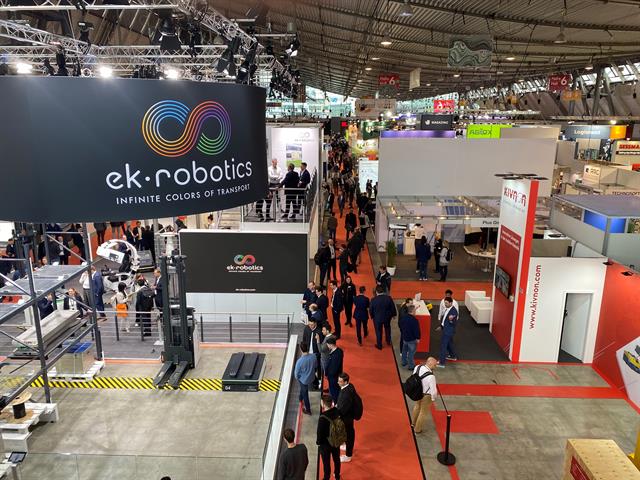 This year's show featured more automation providers
This year's show featured more automation providersThe rapid growth of automation in materials handling was graphically illustrated at the recent LogiMAT conference and trade show in Stuttgart by the expanded number of exhibitors – and the increasing presence of automated solutions at the stands of traditional suppliers.
As the event organisers point out, demand for flexible, scalable warehouse robotic systems is booming, fuelled by a shortage of skilled labour and the need to cut costs.
Experts point out that demand for warehouse robotics has skyrocketed in recent years, driven not only by demand, but also by the plethora of product offerings, many of them providing flexibility at relatively low investment costs.
“Driven by the shortage of skilled labour and the need to cut costs, coupled with the flexibility and scalability of today’s systems, demand in the intralogistics industry continues trending toward non-stationary materials handling technology. AMRs and AGVs interact with forklifts, other mobile robots, and people,” explains exhibition director Michael Ruchty, who notes that LogiMAT has more than doubled the exhibit space allocated to this segment.
Jungheinrich used the event to launch its EAE 212a autonomous mobile robot (AMR).
The EAE 212a is designed for the automation of low-lift operations and requires no additional navigation infrastructure.
Rocla, a division of Logisnext, was among those promoting collaboration between automated solutions and traditional materials handling equipment.
Oskari Lindstedt, solutions sales and marketing VP at Logisnext Solutions, says: “Our solution includes, in the right proportion, both manual and automated solutions carefully refined according to the customer’s needs.”
Adding to the existing range of forklifts, AGVs and warehouse solutions, the company debuted a new model, the Automatic Compact Truck, designed for warehouse applications. It can fit in narrow aisles and lift up to 1,600 kg.
“The integration of manual and automation is the way forward,” he explains. Neither full automation nor total manual operation makes sense for everyone – and even for a single client, there are times when full automation may have to be augmented with manual assistance, for example, in peak seasons, he says.
Among the “mainstream” manufacturers benefitting from the increasing demand for automation, specialist materials handling equipment maker Genkinger has witnessed so much growth that it established a separate department for automation two years ago to develop bespoke solutions in-house.
“The trend is a rising demand for special solutions for automation, and our strength lies in developing solutions with the customer,” says international sales manager Stefan Luhn.
He notes demand for increased capacity for materials handling equipment and more automation requests, adding that the challenge is not so much the application, but more the features of the environment in which it will be deployed.
“For navigation, for example, you have five or six different systems, which requires an intensive onsite survey for each job.”
Genkinger’s business in this competitive market comes from existing customers looking to automate, but also from dealers who understand the company’s capabilities.
Balyo, which adapts forklifts from Linde in Europe and Hyster/Yale in the US and converts them to driverless, is among the manufacturers benefiting from the skills shortage plaguing materials handling.
Marketing and digital director Rob Patey says the reality today is that “people just don’t want to do forklift jobs”.
Balyo has experienced significant year-on-year growth and has refined its manufacturing processes.
“By using standard OEM trucks, we can get them to the customer faster,” he explains, adding that Balyo always has inventory on hand.
Patey concedes that the driverless trucks cost about 50% more than their manual counterparts, but he insists the ROI can be two years or less in a two-shift operation.
Implementation is not just plug and play – the driverless trucks require mapping and fleet managers also have to consider how they will manage their robots. But “the vehicles can run in dual mode, so if you have a busy season, someone can just hop in and drive,” he adds.
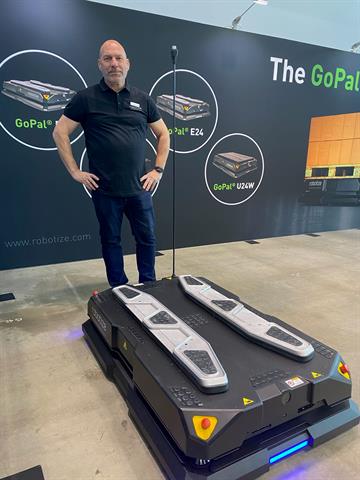 Lars Harding Knutsen
Lars Harding Knutsen
Robotize had two new products on show at LogiMAT: the GoPal E22 AMR which carries europallets up to 500 kg and a new Mobile Lift Station.
Lars Harding Knutsen says his company provides “a complete solution for moving pallets”, including conveyor interfaces, lifting stations and all the integrations required to get the system running.
Robotize, which works with integrators and resellers, is seeing a lot of “slow integrations”. “That’s the beauty of AMRs – it is really easy to start small and scale up. Once you have everything mapped, you can easily add AMRs,” he says.
One of the innovations unveiled at LogiMAT was ek robotics’ Robot Operations Centre (ROC), a combination of teleoperation and artificial intelligence.
Andreas Böttner, CEO of ek robotics, explains that robotics users expect 100% accuracy and efficiency. When things go wrong, the ROC allows a human to take over the operation and find a solution. By adding artificial intelligence, the system “learns” from the human intervention, improving the capability of the robots.
“With ROC, tasks that could not previously be fully automated in a process-safe manner can be solved using teleoperation and artificial intelligence,” Böttner says.
The solution comes against a backdrop of an increasing appetite for automation, with more businesses evaluating the possibility to automate, while those already using AMRs and AGVs are applying them to more processes, he explains. “Where we used to have one application and one vehicle in an installation, now every third or fourth installation is a multi-vehicle installation,” he says, adding that these often require significant customisation.
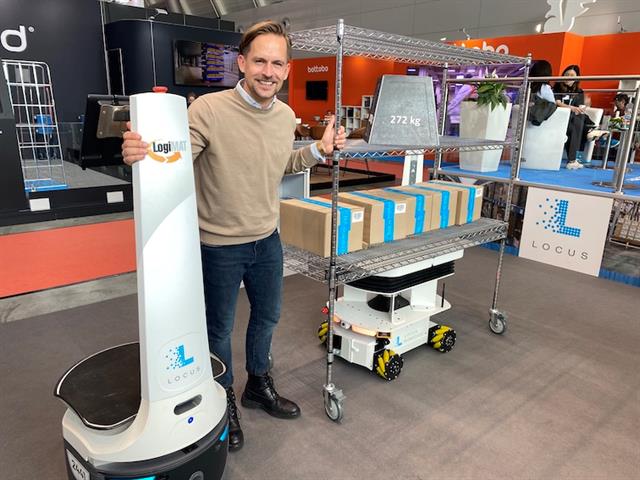 Denis Niezgoda
Denis Niezgoda
Locus Robotics used LogiMAT to unveil two additions to its line-up – Vector, a flexible AMR for materials handling and logistics applications, and MAX, a heavyweight AMR for transporting large, bulky loads up to 1,400 kg.
Denis Niezgoda, VP EMEA and APAC, says the new models both expand the capability within existing use cases and also extend the applications for the company’s AMRs.
Niezgoda claims “no-one can manage fleets as large as us – up to 700 on one site”.
Locus continues to operate on a subscription model which Niezgoda says provides enormous flexibility for customers who can easily add bots during demand surges or reduce their fleet during slow periods.
Spain's Kivnon launched its new K55 Pallet Stacker at LogiMAT. This AGV/AMR model is designed to automate the transport of palletized medium loads at heights to 1.5 m.
Mike Loschinger, country manager for Germany, says the easy-to-use solution is designed to be deployed in both fully automated environments and with manual equipment in mixed fleets.
Knapp attracted a lot of attention with its Open Shuttle Fork, an autonomous mobile robot (AMR) that handles the transport of pallets automatically, space-effectively and flexibly.
“The vehicle is omnidirectional and capable of turning on the spot, so it has the lowest requirement with regard to space usage,” says Gregor Schubert-Lebernegg, product and sales manager.
The vehicle is packed with sensors including a pallet-detecting camera system which allows it to pick up cargo even if is not correctly aligned.
The software operating the vehicle is capable of controlling up to 150 units, with customers empowered to add units and routes on the fly.
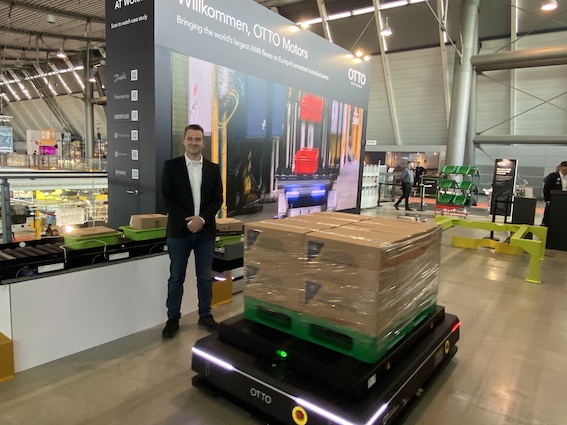 Matt Rendall
Matt Rendall
Canada’s Otto Motors sees its participation in LogiMAT as a success in itself. “After seven years serving the North American market, we feel our foundation is strong enough to allow us to make the leap into another important market,” says CEO Matt Rendall.
The company displayed its Otto 100 and Otto 1500 AMRs and a handful of accessories to support specific applications.
The manufacturer is working with a certified partner network and is initially focusing on building momentum, three years after “soft launching” in Europe.
It already has a parts warehouse in Rotterdam and phase two of the expansion will be to establish a local presence of sales and parts support, Rendall states.
Why Europe? “The simple answer is that our customers are requiring it of us. We are forging deep relationships with large global manufacturers who want a blueprint for automation that can be repeated. And so as part of an RFP in the United States, one of the boxes is ‘Can they support our international operation?’,” he explains.
Navigation remains a major focus for many AMR/AGV manufacturers, and China’s LeiShen Intelligent Systems attended LogiMAT to share its LSLIDAR technology.
Millie Yang, general manager of the ICBG, was on hand to show off a range of sensing and navigational systems, including three-dimensional sensing for AGVs.
The company has plenty of scope for testing its technology since it produces robots in China, and it is looking to share its innovations with robot manufacturers in Europe.
With so many solutions and different vendors in the automation space, many offering stand-alone solutions for limited use cases, the dilemma for end-users is not just which to choose, but how to get them to work together.
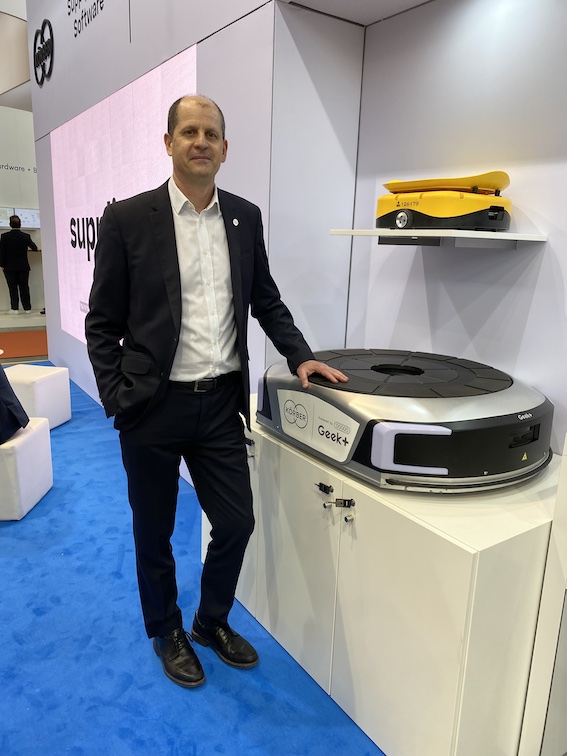 Anton du Preez
Anton du Preez
That’s where providers like Korber can add value, according to Anton du Preez, general manager of robotics, voice, mobility and simulation.
“The challenge is that there is a fairly diverse set of suppliers you can deal with, each with their own technology stack, their own control system, and it’s becoming increasingly difficult to try and orchestrate your operations. Our offer is a universal control system – a manufacturer-independent software layer that can control those processes. More and more, we think customers are going to need a single material flow where you have a range of automation and a range of people in the process that you need to sequence and optimise,” he says.
Du Preez notes growing support for “flexible automation” using robots or AMRs in various combinations with manual processes and allowing businesses to adapt to changing needs.
But, he warns, it is important to align customer expectations with the realities of automation.
“There’s a lot of hype and some great case studies and the risk is that people see the big gains and savings and think that it will apply immediately to them. That’s where we have engagement with customers and look at the operations and then design and fit a system to their reality and needs,” he explains.
- Check out our LogiMAT gallery here and be sure to check back next week for our coverage of the attachments, batteries and accessories at the show.